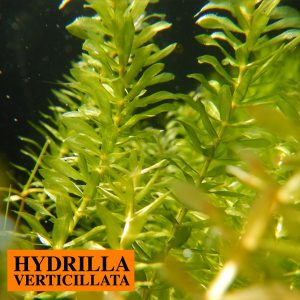By Katie Ray, UF/IFAS Center for Aquatic and Invasive Plants (CAIP) Intern
Happy Halloween from UF/IFAS CAIP! To celebrate the scariest day of the year, we have gathered up five of the spookiest invasive plants haunting around the state of Florida. Some of the plants on our list may simply be frightening to look at, while others have a devastating effect on our state.
Hydrillia verticillata, commonly referred to as hydrilla, may be one of the spookiest aquatic invasive plants haunting Florida’ lakes and rivers. Brought to Florida as an aquarium plant, hydrilla had become an invisible menace by the 1970’s. Growing at about 192 inches per day, hydrilla grows faster than any other aquatic plant. It grows under water until it fills the infested lake or river, “topping out” at the surface. Hydrilla grows so rapidly shading out desired native species, such as pondweeds and coontail with its thick mats. Native plants cannot compete with hydrilla’s rapid growth.
Hydrilla infestations can degrade water quality and lower oxygen levels. Recreationally, hydrilla interferes with boating, swimming, and other activities Floridians enjoy. In addition, dense infestations clog waterways, leading to flooding of nearby areas while clogging essential water pump stations, irrigation, and flood-control canals. Boats and trailers spread Hydrilla to new waters. The state of Florida spends millions of dollars each year on herbicides and mechanical harvesters in an effort to manage hydrilla.
The common name for Morrenia odorata, “strangler vine”, accurately describes this creepy plant. Strangler vine spreads rapidly and chokes out native vegetation around the state. People commonly plant vines in gardens to fill in support structures and provide privacy. However, because of their aggressive and rapid growing habits, they can spread to unwanted areas quickly. Strangler vine can use other plants for support, strangling and killing those plants. In its most recent assessment, strangler vine was determined a high-risk invasive plant.
This frightful grass snuck into the southeastern United States by escaping Satsuma orange crate packing in 1912. In the 1930s and 1940s, it was introduced into Florida as a potential forage for soil stabilization purposes. Later, it was realized cogongrass was of little economic benefit and exposed the potential to be a serious pest. Although new plantings soon became prohibited, the grass spread by illegal plantings. The grass can be seen along roadways, in forests, parks, golf courses, and pastures. In central Florida, cogongrass has established itself in hundreds of acres of reclaimed mining areas. Cogongrass can be found from Florida’s panhandle and well into south Florida. Worldwide, cogongrass infests almost 500 million acres of plantation and agricultural land. It has been found on every continent. Although the grass does not tolerate cool temperatures, cogongrass thrives in fine sand to heavy clay.
Not only is this frightful vine shading out native vegetation in east-central Florida, but it has also become a severe threat to tree islands in the Everglades. Established in Florida in 1965, the Old World climbing fern has become one of the most devastating invasive plants to the state of Florida. Tree islands serve as nesting areas and homes for wading birds and other mammals. These islands are sensitive habitats, often taking thousands of years to form.
The aggressive fern is nonnative and invasive in the state of Florida. It invades moist habitats in South Florida and spreads rapidly without the need of habitat disturbance. Forming dense canopies, the Old World climbing fern also serves as a fire ladder carrying fire to native tree canopies that would not burn under normal conditions. Although this invasive mostly invades public conservation lands, it also can invade residential areas. Each plant releases thousands of spores and are carried by wind, dust, animals, clothes, and equipment.
This eerie shrub has become one of the most aggressive and wide-spread exotic invasive plants in the state of Florida. Brought over to Florida as an ornamental in the 1800’s, the plant has infested over 700,000 acres in Florida. The tree produces a dense canopy and shades out all other desired species. The shrub also creates a poor habitat for native species, invading both aquatic and terrestrial systems. Primarily, birds and mammals disperse the seeds. Brazilian pepper costs the state of Florida millions of dollars annually in management, making its economic impact alone frightful.
This piece was written by Katie Ray, the current UF/IFAS CAIP communications intern. Any questions should be directed to Shelby Oesterreicher at 352-273-3667 or soesterreicher@ufl.edu For more information about the UF/IFAS Center for Aquatic and Invasive Plants please visit https://plants.ifas.ufl.edu. Be sure to follow us on social @UFIFASCAIP.
UF/IFAS CAIP, Turning Science Into Solutions.
 0
0





